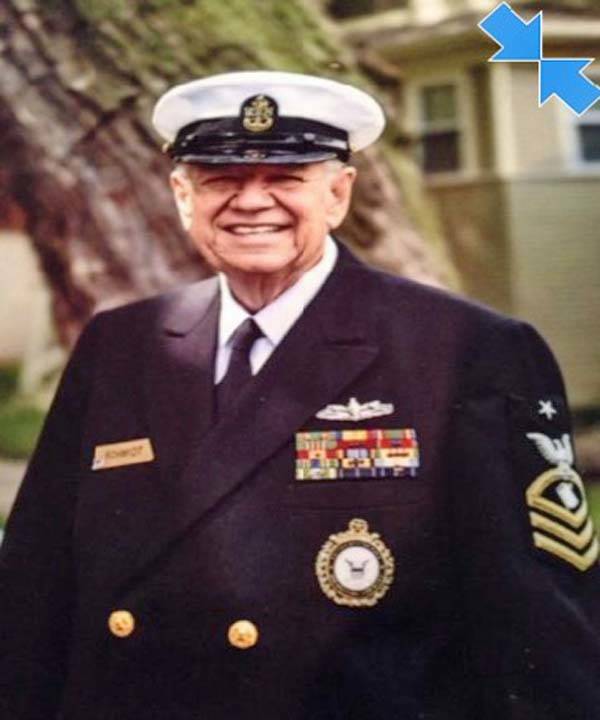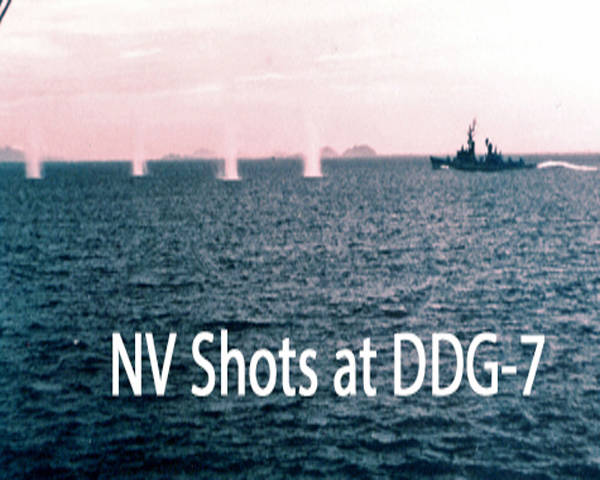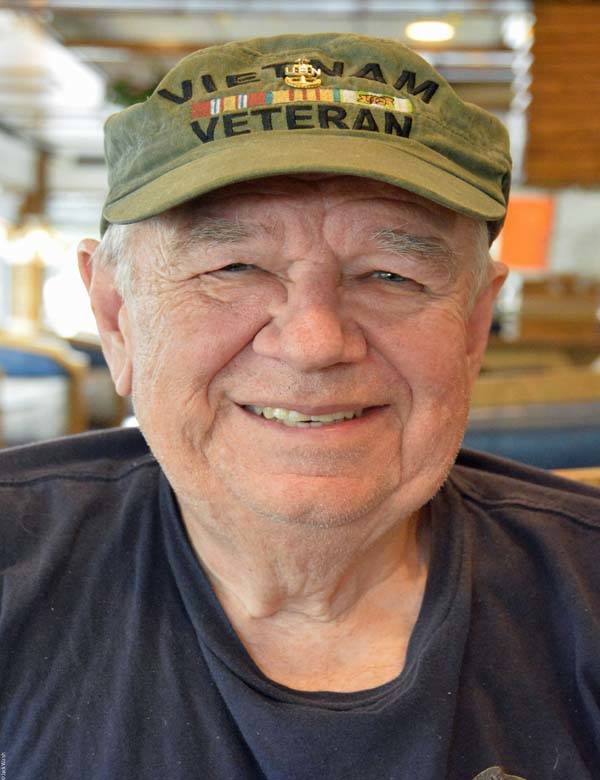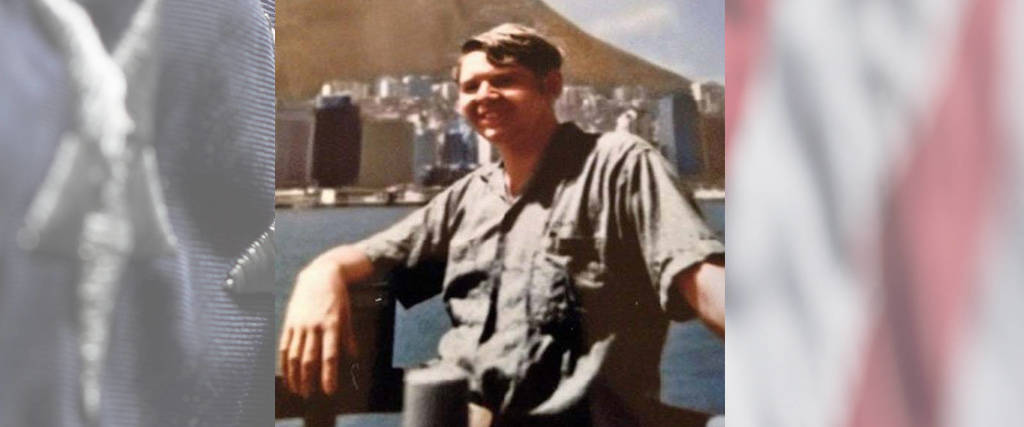U.S. Navy Vietnam War Zion, IL Flight date: July, 2019
By Jack & Ellen Walsh, Honor Flight Chicago Veteran Interviews Volunteer

Terry Schmidt had a long and successful Navy career, with many years of recruiting for the Navy Reserve, but the times he remembers the best are his two tours on a destroyer off Vietnam.
Terry was raised in Dubuque, Iowa, and graduated in 1968 from Wahlert Catholic High School, where he had been one of the top wrestlers in Iowa. The Tet Offensive was going on in Vietnam, and with a draft lottery number of 37, he knew his number would be coming up soon. In the meantime, he went to the University of Wisconsin-Platteville for a year and a half, studying psychology. He knew if he ever ran out of money, his student deferment would end and he would have to do something. “There was a lot of stuff happening on campus, protesting the war. I was pretty neutral.”
Eventually, in 1970 he did run out of money. “I decided to be very proactive and went to the Navy Reserve Center. It was only three blocks from my house – as a kid, I used to go down there on my bicycle. In those days, there were mostly WWII vets, and the stories they told to a 12-14 year old were pretty impressive.” He tried to sign up for the Reserve program, but was told there was a waiting list, with no idea how long it would take. At the time, he was dating Sandi, whom he had met in 1969 when he was on his way to a party at one of Sandi’s neighbors. Walking by her house, he stopped to talk to her and her dad as they sat on the front porch. Turns out, Sandi’s dad had been in the Navy and served on the battleship USS Indiana (BB-58) from 1941-45.
As the war continued, things were looking really grim; the news on the TV every night was about how many servicemen had been killed. In January of 1970, Terry swore in for the Naval Reserve 2×6 program – the newly enlisted would serve 2 years active duty, and then come back for 2 additional years of drilling. That was a very big program back then.
Terry drilled for a while, then went to Boot Camp at Great Lakes. This was followed by a cruise on the USS Hank (DD-702), which had been in the same WWII battle group as Sandi’s dad’s ship the USS Indiana. After the USS Hank, he was given three choices for a Navy career: corpsman, gunner’s mate, and personnelman. “I had really wanted to be a corpsman, but I saw a plaque outside the ship’s office with about 48 names on it of service members killed in combat. Almost all of them were corpsman and gunner’s mates. So I decided I would pick personnelman because I could help people.”
In January 1971, it was off to school in San Diego, and assignment to the USS Henry B. Wilson (DDG-7). He knew of the ship’s reputation as a big gun fighter. It never stayed in port, always going where the fight was. He reported aboard in early April, and was working in the ship’s office. By May, it was on to Vietnam. “Kind of an interesting experience for an Iowa farm boy, but I was seeing the world.”
After a stop in the Philippines for fuel and ammo, they went “on station” off the Vietnam DMZ. “Everyone on the ship was cross trained. Whenever the Marines wanted fire-support, we would lay down a barrage on the mainland. I was fully trained in the Combat Information Center (CIC), including radar scope, on the bridge, navigation detail, etc. We were always short of people.” They were shooting two 5”/54 (Mark 42) guns, with a 45-pound powder casing, 65-pound warhead, and with a range of about 22 miles. It was a rapid-fire gun, capable of about 40 rounds a minute. “We would also go after repair depots, truck convoys – Route 1 along the coast was our bread and butter.”
Terry did two tours on the “Hammerin’ Hank” USS Henry Wilson, in 1971 and 1972. “In 1971, it was you can shoot here, but you can’t shoot there and you can’t shoot there. In 1972, it was you can shoot wherever and take out whatever the hell you want. Normal routine was to be always at Condition 3 or General Quarters. That puts a big strain on the crew because you never get a chance to sleep, because you’re working 12-hour watches. After that, as a support team member, we could then work our regular job if we wanted. It was 16 months at sea, which doesn’t sound like a lot, but it was war time. What I remember is the exhaustion setting in and people falling asleep in the chow line, standing up. It’s just unbelievable. I think that’s what happened with two ships that just collided. They were trying to do too much with too few people.”
In August of 1972, they got a flash radio message that a Chinese freighter had unloaded a “ungodly amount” of ammunition on the island of Hon Me, about 7-1/2 miles off North Vietnam. Intel thought they might have put a minefield in front of it. The Skipper, Commander (CDR) Robert Jensen got the message, and they went in with two other ships. “It was broad daylight, and we stuck out like a birthday candle. Luckily, the enemy was shooting optically; if they had radar, we would have been toast.” Fortunately, the minefield hadn’t been put out in time. Their stern gun was out of action, and then the bow gun jammed, so they had no major shooting ability.

“Our skipper, Captain Jensen, was task group commander and he told our engineering (“snipes”) to “make smoke.” This focused the North Vietnamese firing on us, so that our other two ships could shoot more accurately at the island. Together we were able to destroy about 100,000 rounds of ammunition. Captain Jensen got the Silver Star for this action, and the ship got a Navy Unit Commendation.”
On December 1, 1972, Terry got notice that it was his time to leave. “I was the last of 14 of us being helo’d (helicopter) off; the 13th guy was being winched up when the ship got orders for a fire mission. They yelled at me Schmidt, take the next helo. By that point, I was so tired of war, I grabbed the yoke as the helo was taking off. I went flying over the lifeline, but they were able to winch me on board.”
Finally making it home on leave, Terry and Sandi were married on April 1, 1972, in Dubuque. He came home one Saturday and they got married the next Saturday. “We were going to get married in December, but her mom had cancer and she would never had lived to see it, so it was a good thing to do.”
After Vietnam, Terry went back to drill status in Dubuque and got a job at John Deere, but got laid off. The Reserve Center thought he did a good job, so they sent him down to New Orleans, to the Naval Reserve HQ to work in personnel. When he got there, they put him in the recruiting section, which he found very interesting. At the end of his two weeks, they offered him a six-month assignment. Being unemployed, he took it. “ I was going to try it for 6 months, but I found out I really loved it.” He also found out that the Reserve recruiter in Dubuque was resigning so he applied. “Of course, when you apply for a job in the Navy, you have to run it through the current command first. Well, my boss was the Admiral, and he signed my request and sent it to the Reserve Center Commanding Officer down in Rock Island. He saw the Admiral’s signature, decided to interview me, and I got hired.
“I worked from 1975 through 1989 in Dubuque, and got to be a fixture in the community. I rose through the ranks first becoming a recruiter in charge of a station, then a recruiting zone supervisor for the state of Iowa. I made chief within 10 years, which was kind of unheard of at the time.” A consummate recruiter, Terry recruited his wife Sandi into the Naval Reserves, and she enlisted in 1976. She says they didn’t have any kids at the time so Terry asked Sandi to try it. They both served in Dubuque, Iowa, only in separate stations and different chain of commands. While in Dubuque, Terry earned a Bachelor’s Degree in marketing from the University of Dubuque.
Terry knew the next step would be to go to a Reserve Training Command, and Great Lakes was the closest. He got the assignment as Human Resource Manager at Great Lakes MEPS. “They picked me up and I came over here for four years, retiring from there as Senior Chief Petty Officer, Human Resource Manager in August,1993. I got to handle all the problems, but it was a really people friendly job. It really gave me a good life view. I enjoyed it.” While at Great Lakes, he also picked up his MBA in Human Resource Development.

After his retirement, Terry worked for CDW-G (government) as a representative to the U.S. Marine Corps until he finally fully retired in 2012. Sandi served during Desert Storm, supporting the Reserve Recruiting Command. During her service, Sandi worked different jobs around the Great Lakes. They both served many years on the recruiting side of the Navy, and both were able to get full retirement.
“Most of my career was spent in Dubuque. I came to Great Lakes for the last four years; my twilight tour, at the recruiting command. Most people hated recruiting but we both loved it. It is a tough job, but it has a lot of rewards to it.”
Terry and Sandi have organized and run the USS H.B. Wilson (DDG-7) ‘70-’74 Shipmates reunions for the last five or six years. It is obviously a labor of pride and love. They have a son who is a Navy veteran who served in Iraqi Freedom. They also have a daughter and granddaughter, and are very proud of all of them. Married for 37 years, the two Navy retirees are enjoying their life living in Zion, Illinois.



